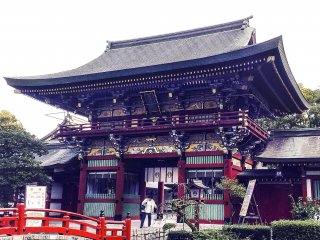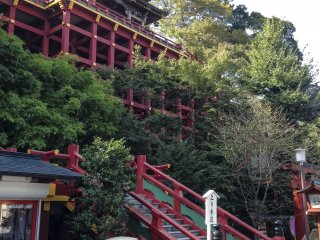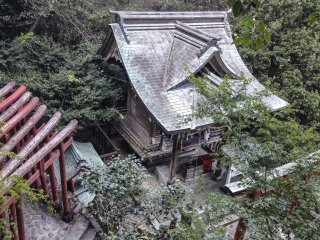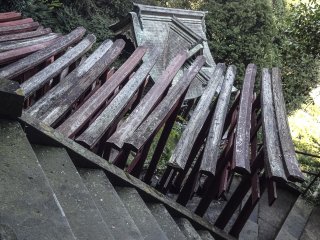The Yūtoku Inari Shrine in Kashima City, Saga Prefecture, is the third largest Inari shrine in Japan. Strikingly majestic, it looks like something you would more commonly find in Kyoto or Nara. Perhaps this is not surprising considering that a princess from Kyoto, Manko Hime, had the shrine built in 1688 to honor Inari, the god of prosperity (as well as rice, tea, and sake). This is truly worth the trip if you are living in or spending any time in Saga Prefecture. There's a lot to take in, so reserve at least an entire day for your trip.
Yūtoku Inari Shrine
Japan's third largest shrine to the god of prosperity

Por Bradford Pomeroy
Community writer
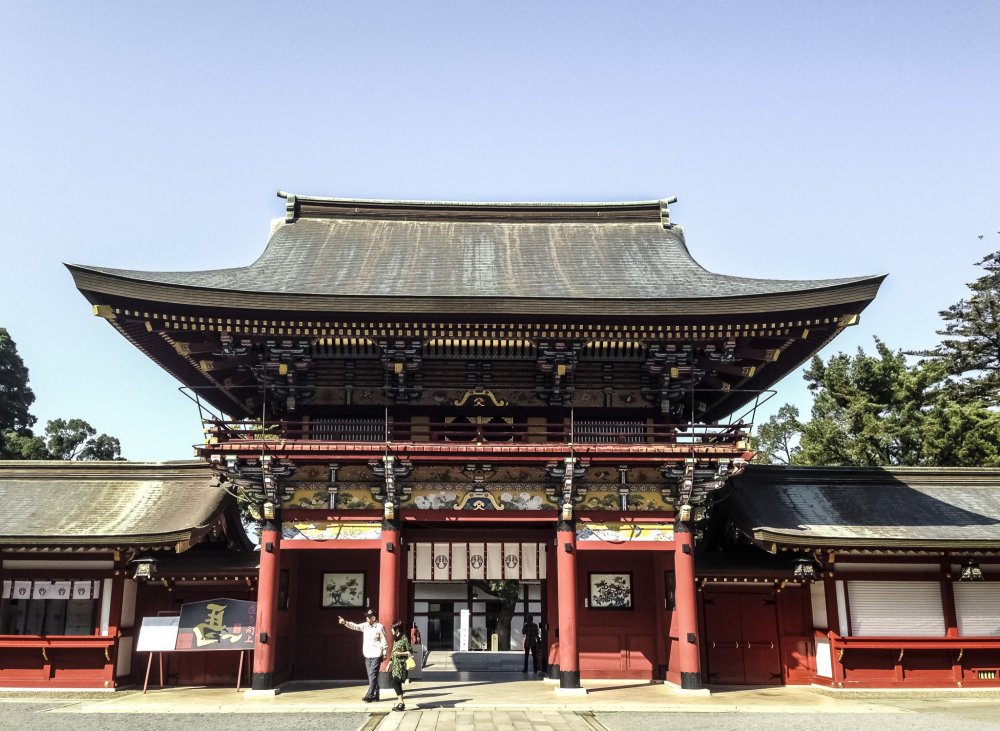
The main entrance to Yūtoku Inari Shrine is an impressive, majestic structure that really sets the tone for your visit.

In front of the shrine there are ponds filled with massive koi (carp) that you can feed or just admire.

The striking vermilion colors against the green backdrop is a very powerful and beautiful sight.

As you make your way up among the various shrines, the colors change and begin to appear more weathered over time.

As you travel along the path, don't get so swept up in the beauty and antiquity that you lose stability. This photo is an example of how narrow the pathway can get. At this point, there is no railing to support you if you fall, so take care!

A shot looking down at the vast array of torii that dominate many of the pathways.

This is a large, carved Furyumen mask. These masks are an important cultural asset to Saga and are utilized by specific participants in various harvest rituals. You will see one at Saga Station as well.

A march of torii that you will pass under as you make your way along the various sites within the shrine.

You will notice a very distinct contrast in terrain. For the lower half of the shrine, you will navigate even steps equipped with hand-rails, but as evident in this picture, the topography changes into very sharp steps and rarely any support. It's a lot of fun, but please be careful at this point.

Clusters of torii can be found almost everywhere you look.

One of the many beautiful views you will see as you continue to make your way to the summit.

A gorgeous view of the mountainous terrain from the main balcony.

This is not your average hike up a hill. These successions of torii and the many smaller shrines and statues that show up during your trek convey a sacred and historic atmosphere.

After your visit, you'll find this shopping area on your way out. Stock up on all kinds of Japanese souvenirs such as local pottery and masks.
Explorar cerca
Deje un comentario
0 comentarios en total
Hacer una reservacion
Find a nearby hotel
Explore some of the best nearby hotels and deals for the perfect place to stay in Japan.
Los mejores artículos
-
![Los Niños lobos - La casa de Ame y Yuki Los Niños lobos - La casa de Ame y Yuki]() 1
1Los Niños lobos - La casa de Ame y Yuki
Toyama -
![Modern: el Restaurante más Chulo de la Ciudad Modern: el Restaurante más Chulo de la Ciudad]() 2
2Modern: el Restaurante más Chulo de la Ciudad
Tottori -
![70 Naciones, Una Comida Increíble 70 Naciones, Una Comida Increíble]() 3
370 Naciones, Una Comida Increíble
Osaka -
![La calle de la guitarra en Ochanomizu La calle de la guitarra en Ochanomizu]() 4
4La calle de la guitarra en Ochanomizu
Tokio -
![Japan Travel Bike: Andar en bicicleta en Japón Japan Travel Bike: Andar en bicicleta en Japón]() 5
5Japan Travel Bike: Andar en bicicleta en Japón
Transporte -
![Guía para visitar Japón Guía para visitar Japón]() 6
6Guía para visitar Japón
Tokio -
![Guía de aduana para Japón Guía de aduana para Japón]() 7
7Guía de aduana para Japón
Planificación -
![Tokio como nunca la has visto Tokio como nunca la has visto]() 8
8Tokio como nunca la has visto
Tokio -
![Explorando Gunma - Templo Ishiuchi Kobu Kannon Explorando Gunma - Templo Ishiuchi Kobu Kannon]() 9
9Explorando Gunma - Templo Ishiuchi Kobu Kannon
Gunma -
![Nintendo TOKYO: la primera tienda oficial de Nintendo Nintendo TOKYO: la primera tienda oficial de Nintendo]() 10
10Nintendo TOKYO: la primera tienda oficial de Nintendo
Tokio
-
![Estatua de Hachiko en Shibuya Estatua de Hachiko en Shibuya]() 1
1Estatua de Hachiko en Shibuya
Tokio -
![Guía de aduana para Japón Guía de aduana para Japón]() 2
2Guía de aduana para Japón
Planificación -
!["Monkey Park Iwatayama" en Kioto "Monkey Park Iwatayama" en Kioto]() 3
3"Monkey Park Iwatayama" en Kioto
Kioto -
![Festival de fuegos artificiales en Yodogawa Festival de fuegos artificiales en Yodogawa]() 4
4Festival de fuegos artificiales en Yodogawa
Osaka -
![Top 10 de lugares en Japón inspirados por el Studio Ghibli Top 10 de lugares en Japón inspirados por el Studio Ghibli]() 5
5Top 10 de lugares en Japón inspirados por el Studio Ghibli
Cultura -
!["Super Potato" en Akihabara "Super Potato" en Akihabara]() 6
6"Super Potato" en Akihabara
Tokio -
![Parque de monos en Kioto Parque de monos en Kioto]() 7
7Parque de monos en Kioto
Kioto -
![La gran Kannon de Sendai La gran Kannon de Sendai]() 8
8La gran Kannon de Sendai
Miyagi -
![Nintendo TOKYO: la primera tienda oficial de Nintendo Nintendo TOKYO: la primera tienda oficial de Nintendo]() 9
9Nintendo TOKYO: la primera tienda oficial de Nintendo
Tokio -
![El Cruce de Shibuya El Cruce de Shibuya]() 10
10El Cruce de Shibuya
Tokio

